Delhi: D
This is a collection of articles archived for the excellence of their content. |
Contents |
Dara Shikoh's library
The Times of India, Sep 21 2015
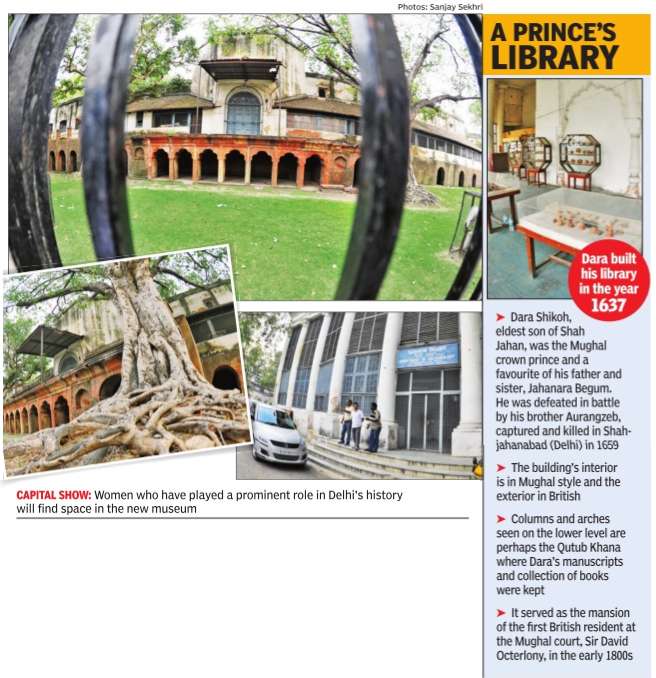
RichiVerma
Guru Gobind Singh Indraprastha University campus
Plan to turn Dara's library into first city museum revived
A unique mixture of Mughal and colonial architecture, the building now shows marks of long neglect
It began life as the library of an emperor-in-waiting 378 years ago[put year] and has since then served as a British residency, a government college, a municipal school, office of the state archaeology department and an archaeological museum. But long neglect and the reduced standing of Dara Shikoh's library near Kashmere Gate now show clearly in its building while plans to covert it into Delhi's first city museum remain on paper. Experts say this building on the campus of Guru Gobind Singh Indraprastha University is unique for its layers of Mughal and colonial architecture.On the northern side, cusped arches and columns--some of them absorbed by walls added later--give it a clear Mughal identity. But alterations and additions made by the British impart an equally strong colonial character. Amid the whitewashed walls, cracked and dusty display cases house a selection of archaeological artifacts for visitors, although it's not a very welcoming place. TOI found it locked up from inside by the guard who doubles as a caretaker.
Dariba Kalan
Daulat ki chaat/ malaiyo/ malai makhan/ nimish
The Times of India, Nov 08 2015
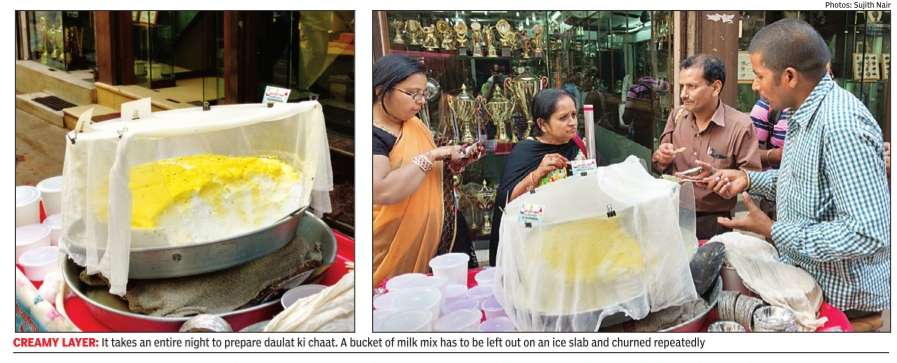
Sujith Nair
Daulat ki chaat, the ultimate desi souffle, returns to capital
A nip in the city air draws a Moradabad fa mily to Purani Dilli, which will be its home for the next five months. Baburam and his brothers churn out a delicacy that can only be conjured up in winter months.Once you spoon their gossamer dessert into your mouth, it disintegrates like the dew in sunlight. Daulat ki chaat, as it is called in Delhi, goes by many names in the north. Malaiyo in Banaras, malai makhan in Kanpur, and nimish in Lucknow. Food historian Pushpesh Pant, who calls daulat ki chaat the “ultimate soufflé“, says the name could have two roots--one, in the name of the man who may have introduced it to Delhi, and the other, in the fact that it was considered a rich dessert.
Third-generation chaatwallas and brothers, Rajesh Kumar, 31, and Baburam, 24, rent a two-room set in Sita ram Bazaar when in Delhi.Baburam wheels his daulat ki chaat pushcart into Dariba Kalan, Old Delhi's jewellery hub, while his elder brother parks his wares in Gali Pa ranthe Wali. Two other relatives man a cart each in Daryaganj and Dariba.
This is a dessert that takes a whole night to prepare. Baburam's recipe goes thus: in an aluminium bucket, mix raw buffalo milk, milk cream, kewra and “samundri panni“, probably a leavening agent though he is not clear on this. Park the bucket on an ice slab through the evening and night. Eight hours later, around 3am, a portion of this mixture can be removed and moved into a larger vessel and hand-churned. Bleary-eyed, Baburam guides me to the ground floor rooms of a building in Sitaram Bazaar. His brother-in-law had just finished the hourlong churning process and worked up a milky foam that is transferred to a large thali.
Baburam takes over the reins as his brother-in-law settles for a quick nap. The business is tough and made tougher by the arrival of new players in the market. Beyond the romance of the sweet chaat, there are really some tough stories. Of sleep-de prived men living in cramped quarters, families that set out with pushcarts every morning and stay on the streets till the last bits are sold.Once winter ends, the family returns to its village to cul tivate wheat, rice and pulses.
The finishing touches to the thali that Baburam is readying come in the form of yellow food colour and a garnish of khoya and pistachios. Baburam says kesar is used only for special orders. At Dariba, he scoops out the foam, places it in a dona and tops it with caster sugar and another hel ping of khoya. A small plate costs Rs 30 and a larger one, Rs 50.
At the other end of the ci ty, in Friends Colony, I meet the man who makes daulat ki chaat through the year. Chef Manish Mehrotra doesn't re ly on the chill winter nights to make this dessert; instead, he uses nitrogen to in stacool the ingredi ents--pasteurised milk, cream, kesar and nuts--before whisking up the fo am. He serves it in a leaf platter placed on an earthen bowl deco rated with fake paper currency notes. “We talk of molecular gastronomy and it is a pity that old Indian specialities like daulat ki chaat are not marketed properly,“ Manish says. He feels that several In dians don't know much abo ut this light dessert, which can be enjoyed even after a he avy meal.
Darya Khan/Kidwai Nagar
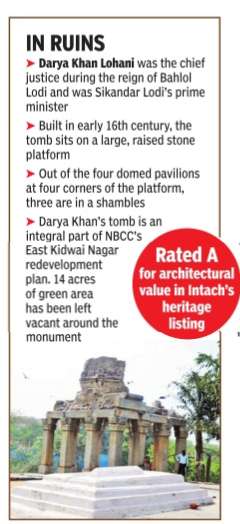
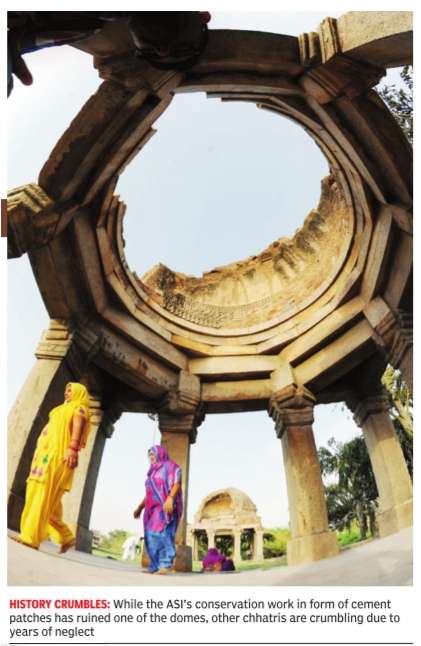
The Times of India Jun 18 2015
Richi Verma
Rescue of 16th-century monument caught in red tape
Covered under a cloud of dust ema nating from the heavy construc tion work for Kid wai Nagar's rede velopment is a 16th century monument--forgotten and surrounded by unkempt grass and a pile of garbage. Years of neglect has left parts of Darya Khan Lohani's Tomb, one of the prime properties of the Archaeological Survey of India (ASI), crumbling.Today, situated right in the centre of the construction area, this tomb rarely finds any visitor. Part of a complex, the tomb is also the resting place of other no bles of the Delhi Sultanate like Mubarak Shah, Kale Khan, Bade Khan, Chhote Khan and Bhuiyan Khan of the Lodhi dynasty . With its unusual architectural style, its four-domed chhatris and a raised platform with an unmarked grave make this structure striking. Now, three of the chhatris are in ruins and the decorative artwork and ornamentation have vanished. The cement patches speak of the conservation work of the past.
As the National Monuments Authority guidelines state that 100m area around the protected monuments should be devoid of construction, experts feel that if the 14 acres of the green area around the monument is developed properly, it could be an ideal tourist destination. An official with National Buildings Construction Cor poration--the organization undertaking the Kidwai Nagar redevelopment said, “The tomb is a cen trally-protected one and we have to be very cau tious. We told ASI that we wanted to adopt the g reen area around the monu ment because it might not be able to maintain it. We proposed installing lights and fountains. We also said we wanted to conserve the monument and maintain the tomb.But, while ASI agreed to let us develop and maintain the green belt, they refused permission to conserve the monument.“
“We had proposed hiring a consultant to conserve the monument as NBCC does not have the expertise or experience to preserve historic buildings. It would, obviously, have been done with the consultation and guidance of ASI, but it refused,“ he added.
Da ASI, though, is Marg apprehensive. A senior ASI official Dilli obindo Haat said, “We welcome corporates INA wanting to adopt Aur monuments through national Sri culture fund. In AIIMS case of the tomb, we have concerns over the conservation work they would do. They would not have the technical expertise, so we would want to handle the structural conservation in-house.“
Barring Humayun's Tomb, ASI's projects with other organizations wanting to adopt monu ments have fallen flat.
SAIL's agreement for Lodi Garden was stalled, Park Hotels' effort at Jantar Mantar never took off and an IOCL fund ing for Qutub Minar are some stark ex amples.
Calling ASI's refusal “unfortu nate“, a conserRoad vationist said, “Anyone can do better than the past cement-based repairs carried out by the ASI. This has only led to further col lapse. It is a pity that no body at ASI can be held accountable and there seems no interest or sys tems within ASI for self-monitoring. It is unfortunate that the ASI refuses suppor t from an agency capable of bringing together professionals and craftsmen ca pable of under taking conservation.“
Meanwhile, the ASI has been facing shortage of manpower and resources. It had, earlier, stated that they were clearly ill-equipped to handle the conservation and main tenance of 3,600 plus centrally protected monuments. Delhi, alone, has 174 monuments. “We are hoping to augment our manpower shortage problem, said an official, when questioned. Experts, however, pointed out that a request for ad ditional 10,000 attendants by ASI has been pending for over a decade.
Daryaganj
Lotanji Ke Chhole Kulche
The Times of India, Oct 10 2015
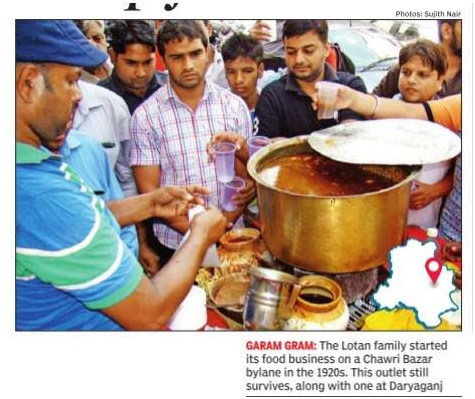
Sujith Nair
Lotanji Ke Chhole Kulche has been feeding schoolkids and adults for nearly 100 years now. Men patiently await their turn around a table on a street in Daryaganj for a drink served in a plastic glass with a cube of butter.
These glasses soon get filled with chhole ka paani -made from the water in which chickpeas are soaked for over 10 hours, and boiled with garam masala.An inter minable stream of customers keeps the fourth generation sellers of Lotanji Ke Chhole Kulche busy from morning till noon. Lotan started selling chhole, kulche and chhole ka paani on the pavement of a Chawri Bazar bylane in the 1920s. His great-grandson, Mahaveer, 40, continues this tradition every morning at the same spot. His clients are mostly residents. At 10am, the action shifts to Daryaganj. Here Mahaveer's younger brother, Deepak, sets up a table right behind Commercial Senior Secondary School, which once housed Lady Shri Ram College for Women. The school and the Lotans have a long connect. “They have been serving chhole kulche to kids in the school's courtyard since the late `50s,“ says former principal IC Ahuja. He adds that Lotan started the business as a noble endeavour -to feed kids during recess on a nonprofit basis.
Now, it is Deepak who sells chhole and kulcha for Rs 10 to the schoolchildren during recess. The same combo costs Rs 25 outside. Physi cal education teacher Rajneesh Gautam, 43, says that he used to relish Lotan's chhole-kulche, in the early '80s, as a student in the same school. Once recess ends, Deepak moves back to the table outside the school. He scoops out chhole from a copper vessel, tops it with aloo and masala -the red spicy concoction with a choice of less, medium or at-your-own-risk! Then follows a spoonful of amchur chutney, a sprinkle of garam masala and a garnish of dhaniya and ginger. Placed alongside a plate of kulche, sourced from a baker in Dariba, the combo is snapped up by eager hands looking for a quick lunch in this publishing hub. The Lotans draw their inspiration from their great-grandfather who loved feeding people. Says Deepak: “Come hell or high water, we never miss supplying this snack to school children. And we never harangue a student or a client who walks off with out paying. Lotanji used to say: `Woh hamara namak kha ke ja rahe hain, par apna naseeb chhod ke.“
Chana soup aka chhole ka paani
Chickpeas are soaked in water for about 10 hours before these are cooked. This water is decanted and boiled, with a dash of garam masala, to make chhole ka paani. Chickpea is then cooked separately and mixed with chhole ka paani over the counter and sold as chana soup topped with a cube of butter.
Defence Colony
Defence Colony market
The Times of India, Jul 28 2015
Amin Ali
A market that failed to sell itself
Poor infra, lack of innovation and limited options stunted Defence Colony market
Foto Mart, set up in 1961, survived the technological onslaught at a time when thousands downed the shutters for good. But for Sharma, this success came at a cost. He devoted a major section of his shop to Pet Land--an outlet selling products for pets--in 2002. And while his shops stood the test of time, the market is still stuck in a time warp. In the middle of bustling south Delhi, certainly an enviable location, the market is rapidly losing to the likes of GK, South Extension, Lajpat Nagar, Saket and Khan Market. Blame it on the lack of innovation, fewer shopping options and poor infrastructure. Even a handful of international fast food chains had to shut shops within a couple of years.
The market couldn't evolve beyond its character of a neighbourhood one. There are no big dining spaces or retail brands here like in Hauz Khas Village or Mehar Chand Market.
Jaspal Singh Sahni of Kents, a fast food outlet that opened in 1985, says the market had a south Indian dining option in Sagar Ratna, and departmental and grocery stores besides his own fast food joint much before other markets. But with hardly any additions, the market seems to have lost the race.
Shopkeepers blame the market association. They claim to have complained about the lack of basic amenities but to no avail. “The market association exists only in name. A weak union means that all plans remain only on paper,“ says Sahni.
A walking plaza is a dream being sold to the residents here for a good 25 years.Add to it the parking woes, sewage issue, traffic congestion and the few badly-main tained toilets. “The market enjoys a good location facing the park. It should have been a place where locals could have enjoyed a stroll. But total lack of planning has forced people to avoid it,“ says Harjit Singh, a resident of the colony for the past 56 years. He has leased out his shop to a Thai eatery.
While other markets see a new outlet open almost every week, any new addition to Defence Colony market is news. “This market isn't drawing customers. But it made good sense for us to open an outlet here,“ says Luvleena Saggu, owner of newly-opened Giani icecream outlet. She is among those who have seen the market over years and feels that even if it's not fast-paced, a loyal customer base could give it a new lease of life.
Masjid Basti Baoli
The Times of India, Jul 05 2015
Amin Ali
Built in 1488, this mosque has had its share of ups and down. The mosque used to get only a handful of people when the present imam took over. It had a railway line running next to it and was surrounded by vast secluded stretches. “It used to be scary post sunset, especially with hardly any company,“ recalls imam Eisa. As a way to overcome this problem, a madrassa was started within the premises so that the imam would have students for company in namaaz.
Just as the neighbourhood markets started emerging as popular retail and dining destinations in the city , the mosque too became the place to pray for professionals in the area.
“Most of the people who pray in Masjid Basti Baoli are workers who come from different parts of the city. The mosque is a meeting point for such people to fulfil their religious duties and get a feel of community ,“ says Adnan Ansari, a regular.
Dwarka
See also: